Effective wearable battery health monitoring requires tracking state of charge drop rates, temperature levels, and charge cycles. You’ll benefit from smart throttling systems that adjust power based on usage patterns and thermal conditions. Look for devices with customizable alerts, ship mode for storage, and predictive analytics that forecast capacity decline. Thermal protection is essential in compact designs, with features that prevent overheating during charging. The right monitoring features can extend your device’s lifespan dramatically.
Real-Time Battery Diagnostics: What Metrics Really Matter
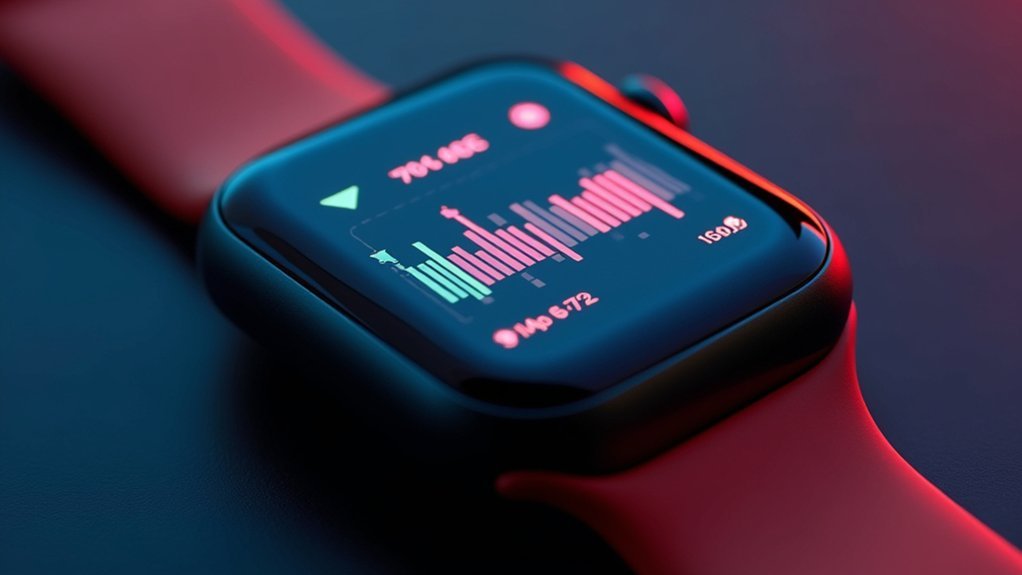
While many battery metrics flood diagnostic dashboards, five key indicators truly drive effective health monitoring in wearable devices.
State of Charge drop rate provides critical runtime estimates and helps detect software-induced drain regressions through hourly heartbeat intervals.
Temperature monitoring with FBG sensors identifies hotspots before thermal runaway, offering 200°C warning thresholds that surface readings miss.
Meanwhile, charge cycle analytics track depth-of-discharge patterns and flag overcharge incidents that accelerate degradation. Comparing performance across multiple firmware versions can reveal unexpected battery behavior that requires immediate investigation.
For longer-term insights, predictive health modeling combines physical measurements with electrochemical models, enabling 10-cycle capacity forecasting.
Finally, user-centric metrics separate active-use from standby drain, quantify peripheral impacts, and correlate environmental conditions with performance—giving you personalized alerts based on your unique usage patterns.
Smart Charge Cycle Management for Extended Lifespan
Smart management of your wearable’s charging cycles requires implementing charge throttling techniques that adjust current levels based on battery capacity and usage patterns.
You’ll gain significant battery longevity by programming charge rates between 0.5C and 1C, which prevents the lithium deposition that occurs during aggressive fast-charging.
Your device can further combat battery aging by utilizing temperature-aware charging algorithms that automatically reduce current when thermal conditions threaten cell integrity. The charging circuit should disconnect power when the battery temperature exceeds 25~50°C range, as excessive heat significantly degrades lithium-ion battery performance.
Charge Throttling Techniques
Despite their small size, modern wearables employ sophisticated charge throttling techniques that dramatically extend battery life. These methods dynamically adjust charging parameters to prevent battery stress while maintaining peak performance in your daily-worn devices.
Advanced throttling features in quality wearables include:
- Dynamic current control that automatically adjusts charging rates based on battery health and temperature conditions.
- Autonomous headroom tracking which optimizes voltage levels to reduce power loss without additional components.
- Temperature-responsive charging that slows or pauses charging when your device gets too warm.
- State of Charge monitoring systems that prevent harmful overcharging by precisely tracking battery fullness.
These techniques work silently in the background, requiring specialized Power Management ICs (PMICs) that can deliver up to 90% charging efficiency while minimizing heat generation. The implementation of SIMO architecture in modern wearables has shown to improve fast-charging speeds by nearly 4 times while maintaining lower operating temperatures than traditional solutions.
Battery Aging Prevention
Battery aging stands as the primary limiting factor for wearable longevity, making smart charge cycle management a powerful ally in extending your device’s usable life. By carefully monitoring recharge patterns, you’ll preserve the high energy density cells that power today’s compact wearables.
Effective aging prevention requires maintaining ideal temperature ranges during charging and implementing programmable charge currents tailored to your specific battery profile. Modern wearables incorporating solid-state batteries offer significantly improved safety benefits that reduce aging concerns. Look for wearables with precise termination current accuracy, which guarantees maximum energy input without degradation.
The most advanced systems now incorporate real-time monitoring with fault detection capabilities that prevent harmful overcharging. When paired with power path management, your device can intelligently switch between battery and direct power, reducing unnecessary cycles.
Remember that lithium-ion cells respond well to partial charges rather than frequent complete depletions.
Thermal Protection Systems in Compact Wearable Designs
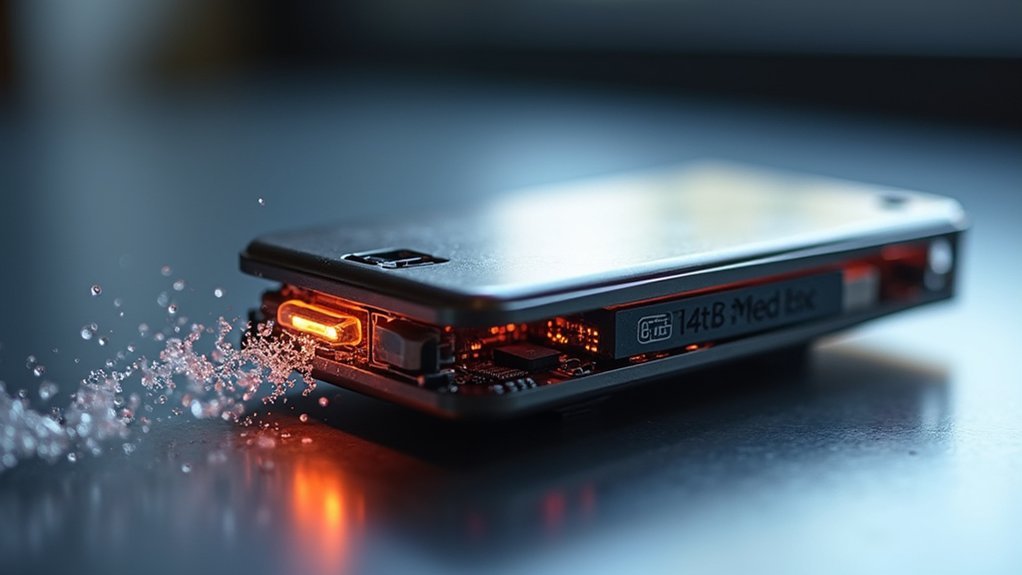
Wearable devices now feature miniaturized heat diffusion technologies that prevent battery overheating while maintaining their sleek profile.
You’ll find smart throttling mechanisms that automatically adjust performance when thermal thresholds are approached, balancing functionality with safety.
Recent material science breakthroughs, including flexible PCMs and ultra-thin thermistors, have revolutionized how your device manages heat in extremely limited spaces.
Effective heat management systems incorporate five thermal strategies including conduction, radiation, evaporation/convection, heat absorption/release, and thermoelectric cooling to ensure optimal wearable device performance.
Miniaturized Heat Diffusion Technologies
Thermal management presents significant challenges in compact wearable design, where space constraints collide with battery safety requirements. Effective heat diffusion technologies protect both your device and skin while maintaining ideal battery performance.
Modern wearables employ several miniaturized approaches to manage heat:
- Metafabrics integration – Advanced textiles that combine evaporative and radiative cooling effects without bulky components.
- Nanomaterial layers – Ultra-thin thermal interface materials that efficiently transfer heat away from critical components.
- Component optimization – Strategic placement of heat-generating elements to maximize natural convection.
- Passive cooling structures – Micro-channeled designs that enhance airflow around battery compartments without requiring additional power.
These technologies eliminate traditional heat sinks while maintaining safe operating temperatures, extending battery life and preventing potential thermal damage to sensitive electronics. Prolonged contact with the skin increases the risk of burns if thermal management is inadequate, with international standards showing that devices must remain below 48°C for contact exceeding 10 minutes.
Smart Throttling Mechanisms
While passive cooling structures address physical heat diffusion, effective wearable thermal management also requires active intelligence. Your device constantly monitors its thermal state and automatically adjusts performance to prevent overheating that could damage the battery or components. These systems are crucial for longer battery life which is essential for wearable reliability.
| Throttling Component | Function |
|---|---|
| Thermal sensors | Detect temperature spikes in real-time |
| Power Management ICs | Regulate voltage and current distribution |
| DVFS systems | Adjust processor clock speeds as needed |
| Task schedulers | Prioritize operations for thermal efficiency |
These systems work together to implement algorithmic throttling based on usage patterns. When your wearable approaches thermal thresholds, it’ll dynamically reduce power consumption while maintaining essential functions. You’ll notice this intelligent compromise between performance and heat management especially during processor-intensive activities, ensuring battery longevity without compromising your experience.
Material Science Breakthroughs
As electronic components shrink to accommodate sleeker wearable designs, revolutionary materials have emerged to combat the intensified thermal challenges in these compact spaces.
You’ll find these innovations vital for maintaining battery health while preserving device functionality.
Recent breakthroughs include:
- Passive radiative coolers that dissipate heat without consuming power—essential for extending battery life in your daily-wear devices.
- Metal-Insulator-Metal structures that enable colored cooling surfaces while maintaining efficient thermal management.
- PDMS encapsulation that enhances infrared emissivity, protecting internal components from heat damage.
- AeroZero® and similar compact thermal protection solutions that shield critical components during thermal events.
These advancements directly address the challenge of reconciling thermal management with the competing demands of flexibility, biocompatibility, and size constraints in your wearable devices. Optimal positioning of heat-sensitive batteries away from heat-generating components ensures longer operational life and prevents premature degradation in modern wearables.
Predictive Analytics: Forecasting Battery Decline Patterns
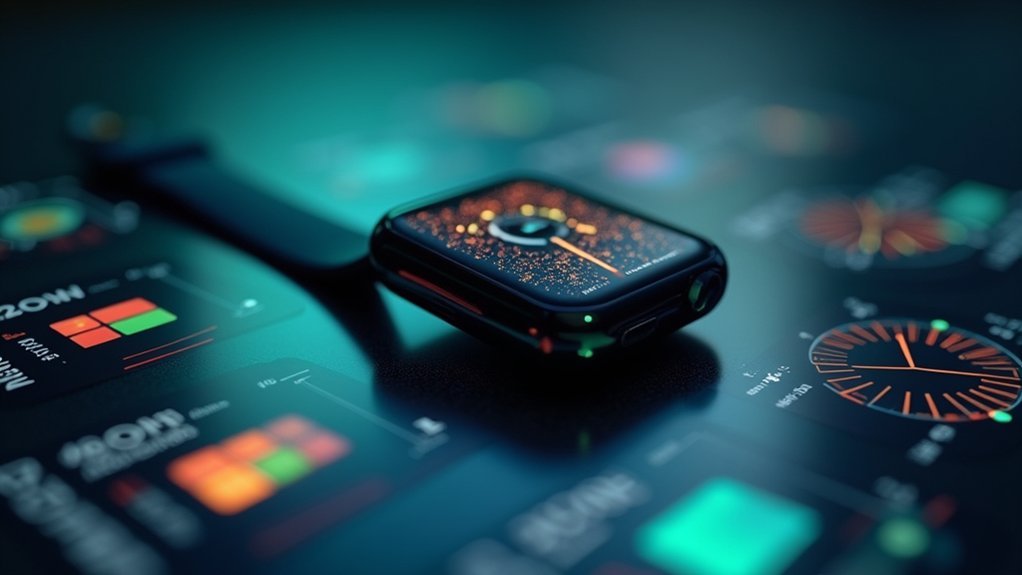
Since wearable devices have become integral to daily life, understanding their battery health has emerged as a critical concern for users and manufacturers alike. Predictive analytics now offers powerful solutions to anticipate battery issues before they occur.
Your device constantly gathers data on usage patterns, sensor activity, and environmental conditions to forecast battery decline. Machine learning algorithms track charge cycles and analyze how temperature affects battery performance, enabling early detection of potential problems. Modern wearables leverage specialized software platforms to process and analyze vast amounts of battery performance data. You’ll receive proactive maintenance suggestions that can greatly reduce unexpected failures and extend battery life.
Despite implementation challenges like computational limitations and data complexity, the future looks promising. AI integration, advanced materials, and personalized predictions will soon enhance these capabilities, giving you more reliable devices and manufacturers valuable insights for future designs.
User-Configurable Battery Alerts and Emergency Modes
Modern wearable devices now offer sophisticated battery management systems that put you in control of your device’s power status.
You’ll never be caught off-guard by a dead battery again with customizable alert thresholds tailored to your specific usage patterns.
- Set personalized thresholds for different devices—configure your fitness tracker to alert at 30% while setting your medical wearable to notify at 50%
- Choose your notification method from push notifications, emails, or SMS alerts based on urgency
- Implement emergency protocols with panic button functionality and GPS tracking for critical situations
- Access real-time monitoring across multiple devices through unified management systems that prioritize alerts by importance
These customizable features guarantee your wearables remain operational when you need them most, especially during emergencies or important activities. You can easily manage notification preferences for all wearable and wall-mounted panic buttons through the 911Cellular Portal under Settings.
Ship Mode and Ultra-Low Power States for Shelf Life
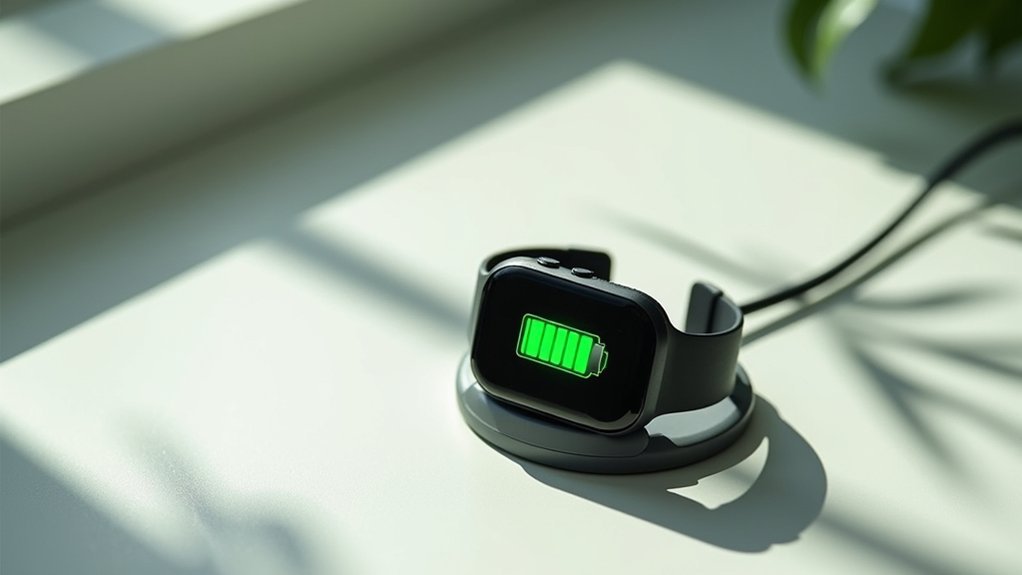
While managing battery alerts keeps your device running during daily use, manufacturers face a different power challenge before your wearable ever reaches your wrist. Ship mode addresses this by placing devices in a high-impedance state that dramatically reduces current leakage.
You’ll benefit from ship mode without ever knowing it’s there. This ultra-low power state guarantees your device arrives with a near-full charge and minimizes premature battery aging during storage. Key components like load switches and low-IQ technologies isolate the battery from unnecessary discharge.
Manufacturers must carefully balance power preservation with maintaining essential functionality. They select specialized PMICs and smart switches that facilitate seamless shift from ship mode to active use. This approach represents a critical design consideration for ensuring optimal battery performance over the device’s lifetime.
This thoughtful design extends shelf life and delivers the out-of-box experience you expect from your wearable.
Wireless Charging Optimization for Daily Wearables
Wireless charging has revolutionized how you power your wearable devices, eliminating tangled cords and fragile connection points.
Embrace the freedom of cord-free living as wireless technology transforms how we energize our wearable tech.
Today’s wearables use various technologies from inductive charging in smartwatches to hybrid systems that combine near-field and far-field approaches for ideal efficiency.
For maximum battery health and charging effectiveness:
- Position matters – Align your device properly on charging surfaces to benefit from technologies like Adaptive Rectifier Configuration that improve spatial freedom.
- Consider device-specific solutions – Different wearables (smartwatches, earbuds, smart glasses) require tailored charging approaches.
- Monitor power levels – Most wearable charging systems deliver 1-2.5W, fine-tuned for your device’s specific needs.
- Check compatibility – Verify your charging solution meets safety standards while delivering efficient power transfer.
Emerging microwave wireless power transmission technology offers potential for continuous charging capability as long as devices remain within the transmitter’s range.
Battery Health Data Integration With Fitness Platforms
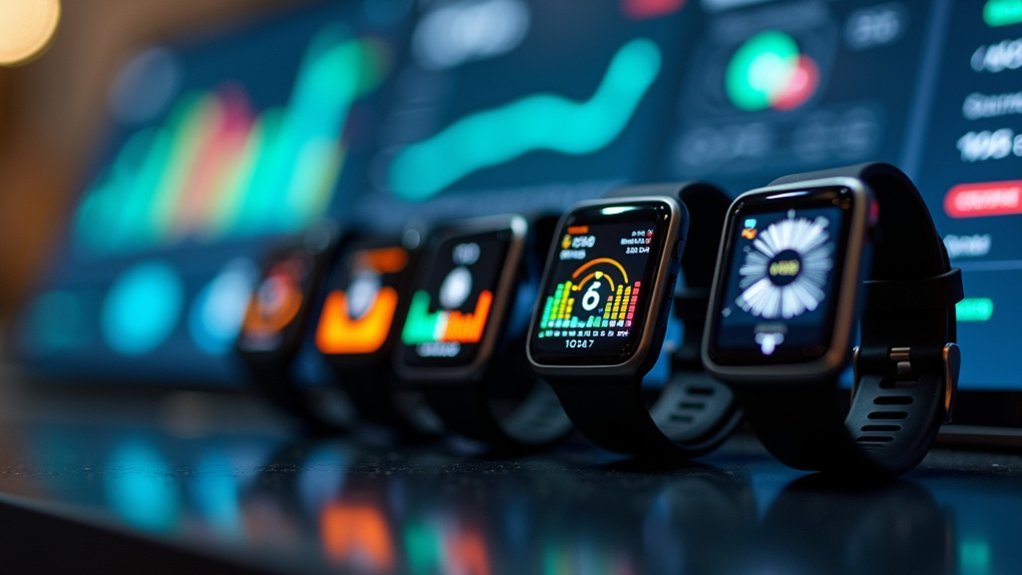
Seamless integration between battery health data and fitness platforms represents a critical advancement in wearable technology, enabling you to make informed decisions about both your health and device usage.
When your fitness apps access battery health metrics, they can enhance tracking activities based on available power. This integration relies on standardized synchronization protocols that guarantee data consistency across multiple devices. Data security measures are crucial when handling battery health information alongside personal fitness metrics.
You’ll benefit from sophisticated power management algorithms that extend battery life while maintaining accurate health monitoring. AI-powered analysis provides personalized insights about your usage patterns, helping you maximize both fitness outcomes and device longevity.
For best results, look for platforms that support cross-platform consistency and incorporate advanced biometric sensors. These features guarantee your health data remains accurate and secure while your wearable maintains peak performance throughout your fitness journey.
Frequently Asked Questions
How Does Cold Weather Affect Wearable Battery Performance?
Cold weather slows your wearable’s battery by decreasing ion mobility, increasing resistance, and reducing capacity. You’ll notice faster draining, shorter usage times, and delayed charging when temperatures drop. Insulation can help maintain performance.
Can Using Third-Party Chargers Damage My Wearable’s Battery?
Quality third-party chargers won’t damage your wearable’s battery if they meet proper standards. However, low-quality ones may cause overheating, inefficient charging, or fail to regulate voltage properly, potentially shortening battery lifespan over time.
Is It Safe to Wear Devices During Battery Replacement?
No, you shouldn’t wear devices during battery replacement. You risk electrical shock, chemical exposure, and potential injury. Always power off completely and remove the device from your body before attempting any battery replacement procedure.
How Often Should Wearable Batteries Be Professionally Inspected?
You should have your wearable batteries professionally inspected every 12-24 months, or sooner if you notice performance issues. Follow manufacturer guidelines and consider annual testing once capacity drops below 90%.
Do Magnetic Accessories Interfere With Battery Health Monitoring Systems?
Magnetic accessories may occasionally interfere with your device’s battery health monitoring systems. Most quality wearables include shielding to protect against this, but you’ll want to use manufacturer-approved magnetic accessories for best results.
In Summary
Your wearable’s battery isn’t just a power source—it’s the lifeblood of your device. By focusing on real-time diagnostics, cycle management, and thermal protection, you’ll extend its lifespan considerably. Don’t overlook the value of predictive analytics and customizable alerts. Remember to utilize ship mode when storing devices and optimize wireless charging habits. Integrating battery health data with your fitness platforms completes a truly thorough monitoring approach.

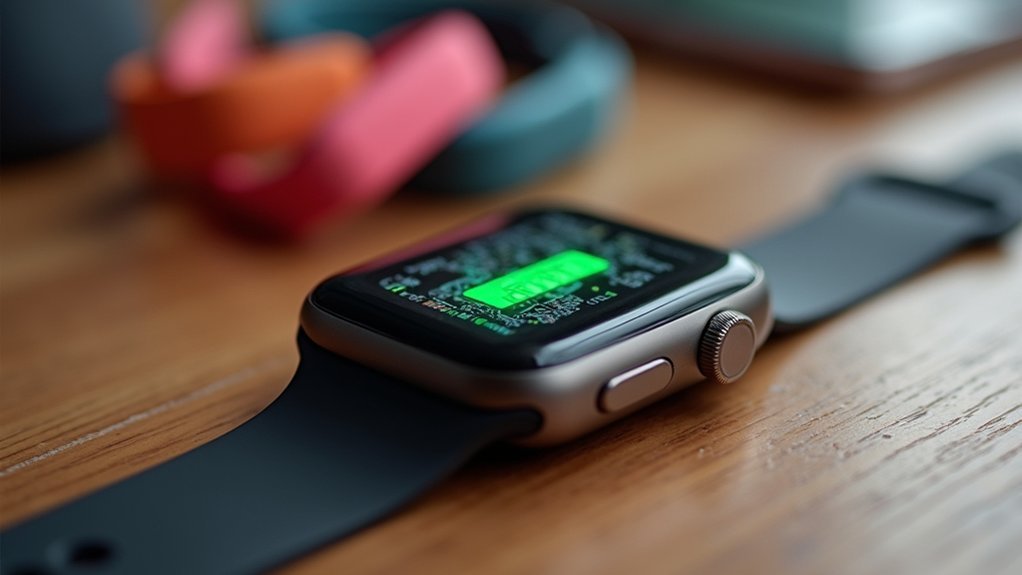

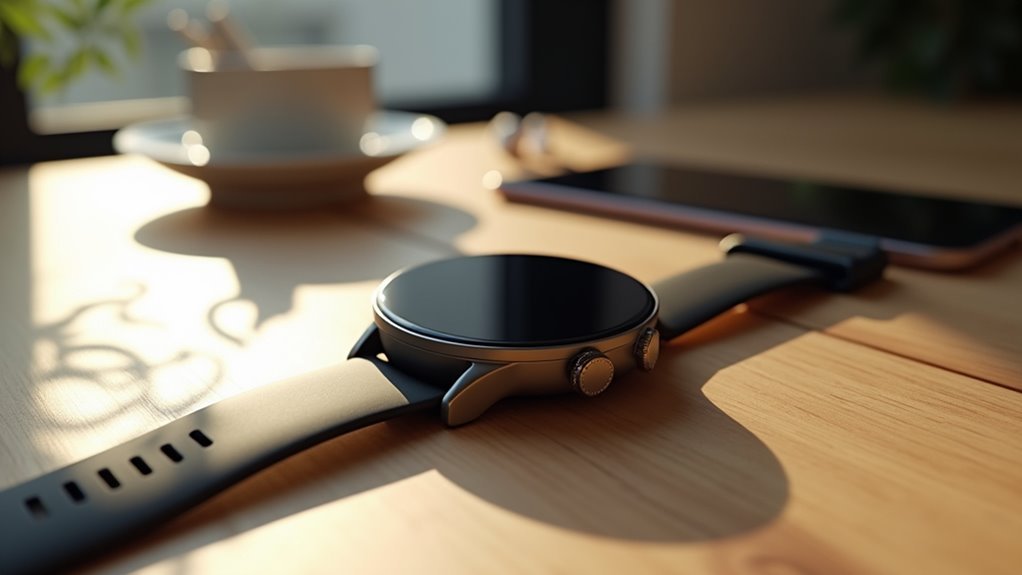
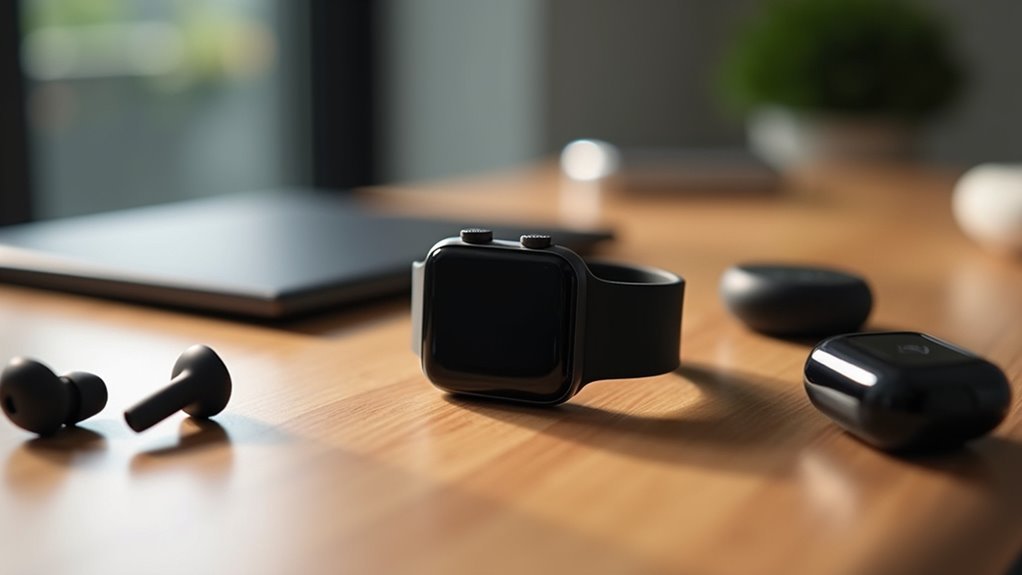
Leave a Reply